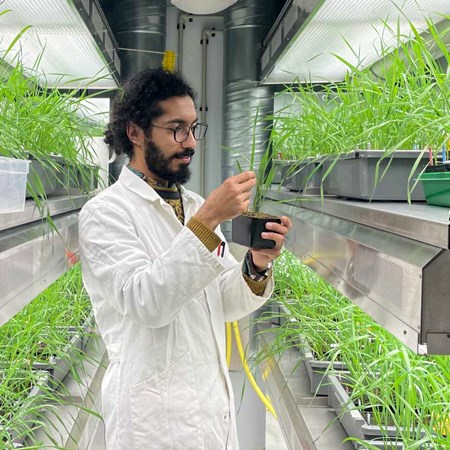Plant genotype-dependent biocontrol of wheat diseases

Genetic variation in plants can affect how efficiently biological control agents can reduce diseases. In this doctoral thesis, Sidhant Chaudhary has investigated this variation to bring us closer to optimising crops for higher biocontrol responsiveness.
Today, the agricultural sector is one of the biggest contributors to climate change. To maintain high production, current agricultural practices rely heavily on fertilisers and chemical pesticides to protect against pests and pathogens. An alternative to traditional pesticides is biological control, a method where beneficial organisms are used to manage pests and pathogens.
Plant and microbe interactions are important for pathogen control
Many biological control agents are microorganisms, and they can vary in performance and efficacy due to various biological and environmental factors. One of the factors is the interactions of these microorganisms with plants. These interactions involve complex molecular mechanisms, which aid plants in recognising pathogens and other microorganisms.
At the same time, microbes utilise molecular strategies to overcome or suppress plant defences. It is established that the genetic variation of plants makes some individuals, or genotypes, more or less susceptible to pathogens than others.
– Today, we do not have a sufficient understanding of how plant genetic variation can influence the efficacy of biological control agents, says Sidhant Chaudhary.
Many factors determine biocontrol efficiency
In his doctoral thesis, Sidhant has therefore investigated how different landraces and cultivars of winter wheat interact with the beneficial fungus Clonostachys rosea. A fungus that has the potential to control harmful plant diseases as well as promoting plant growth. Using around 200 different wheat genotypes, he tested how well C. rosea could fend off two major fungal pathogens that threaten wheat production: Zymoseptoria tritici, which causes septoria tritici blotch, and Fusarium graminearum, the culprit behind fusarium foot rot.
– Both the vulnerability of wheat to disease and how well C. rosea worked as a biological control varied widely depending on the wheat cultivar. In other words, not all wheat plants responded to C. rosea in the same way—and its effectiveness could also depend on which pathogen was present and which part of the plant was infected, says Sidhant.
Potential for implementation in plant breeding efforts
Wheat cultivars that were more susceptible to disease also tended to benefit more from C. rosea. Using a genetic analysis technique called genome-wide association studies (GWAS), he identified specific genetic markers linked to both disease resistance and biocontrol effectiveness. These traits seem to be inherited independently, which may offer future wheat breeding programs the possibility to target both traits at once—developing plants that are both less disease-prone and more responsive to beneficial microorganisms like C. rosea.
– We also explored the gene activity in two wheat genotypes that differed in how well they responded to C. rosea. By analysing their early immune responses during exposure to both the harmful fungus and the biocontrol fungus, we observed time-dependent differences in immune responses of both plant genotypes in presence of C. rosea and the pathogen, says Sidhant.
We now have a better understanding of how wheat plants interact with biological control agents. This knowledge brings us closer to optimising crop varieties that naturally resist disease and that are more suitable for biocontrol application, helping to reduce our dependence on chemical pesticides and build more sustainable farming systems.
Sidhant will defend his thesis 9 May 2025.
Read more about the defence here.
Links:
Sidhant Chaudhary’s doctoral thesis “Plant genotype-dependent biocontrol of wheat diseases”
The thesis defence 9 May where you can participate online or in person
Sidhant Chaudhary´s PhD project is a part of SLU Grogrund´s research on interactions between crops and microorganisms